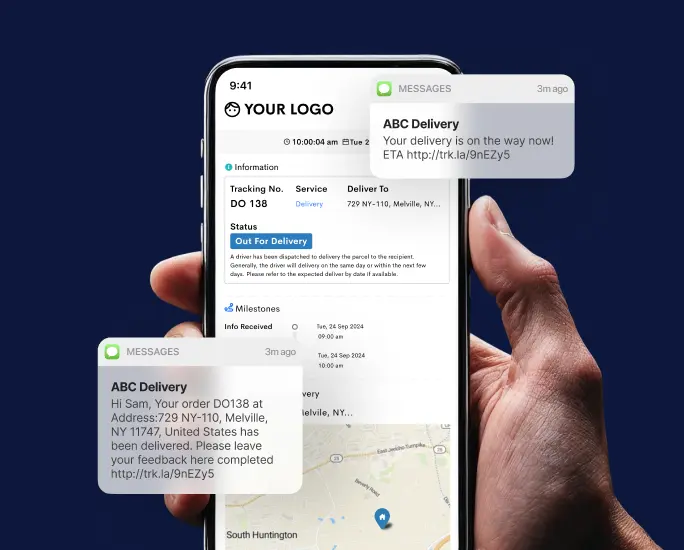As businesses increasingly rely on goods delivery to get their products out to customers, it’s important for organizations of all sizes to have an efficient and well-thought-out delivery system in place.
Unfortunately, no matter the size of the organization or the scope of its delivery services, businesses can still face some common logistical issues that can disrupt their delivery operations.
Organizations need to understand these often recurring issues to effectively address any potential challenges and solutions for addressing them.
This article will help break down some of the most common delivery logistics issues and offer effective solutions so businesses can continue providing timely deliveries without interruptions.
Logistics Issues Broken Down
Planning & Risk Management
Planning and risk management are essential components of logistics. Without a well-developed plan, even the best strategies can fail due to insufficient resources or unexpected events.
A successful logistics operation must anticipate potential risks and be prepared to deal with them effectively. This means accurately assessing the costs associated with a particular route or method, preparing for safety issues, understanding applicable regulations, and taking into account changes in the supply chain landscape.
Handling Customer Expectations
The logistics industry provides businesses with a complex network of services designed to help them save time, money, and resources. The challenge lies in ensuring customer expectations are met while maintaining efficient operations and cost-effectiveness.
Logistics companies must provide individualized delivery services that can be tailored to meet the needs of each client. Keeping track of multiple stock levels and anticipating supply chain disruptions is essential, as is making sure all orders are fulfilled on time.
Additionally, customers expect any potential disruption in delivery services to be communicated quickly and routinely to minimize the impact on their business operations.
Transportation Cost
Managing the cost of transportation is a critical part of any logistics strategy, as it can have a huge impact on the bottom line. It’s important to review your transportation costs regularly and look for areas where you can save money.
Consider utilizing the services of third-party logistics providers or local carriers for shorter distances and less urgent shipments, which are typically cheaper than using an international carrier.
Additionally, review your transport routes to ensure you’re getting the most bang for your buck out of each shipment – repetitive routes from one customer can often be consolidated into single trips.
Warehouse Management Errors
Warehouse management can be daunting as it is one of the most intricate logistics issues. From keeping track of thousands of items to ensuring proper security procedures are followed, warehouse operations must be well-planned and organized.
However, these systems can quickly become overwhelmed by errors or unforeseen issues. Such imperfections can lead to increased costs due to inventory shortages, incorrect orders, or time wasted searching for misplaced stock.
To ensure any discrepancies are caught in time and corrective action taken, warehouses should employ digital solutions to analyze available data and identify patterns related to potential errors.
Inconsistencies In Tracking
Keeping track of shipments is essential for a successful business as it guarantees products will get from A to B on time and in one piece. Any inconsistencies or mistakes in tracking can lead to delays, loss of credibility, and unnecessary costs.
This is why ensuring shipment tracking remains accurate and consistent becomes increasingly important when managing an ever-changing logistic landscape. While automation helps reduce manual data entry errors, problems usually arise when outdated technology isn’t used.
Suppose your software can’t record the most up-to-date product origin and destination information. In that case, orders might get interrupted or delayed due to a lack of visibility within the system.
Sourcing Reliable Carrier Capacity
One of the key logistics issues is the ability to source reliable carrier capacity. Without the right contracts and agreements in place, it can be difficult to acquire the capacity needed to expedite shipments on a timely basis.
To ensure that capacity is available, companies must develop trust-based relationships with carriers and ensure that carrier services are flexible and cost-effective. This requires accurate forecasting for future demands and intense due diligence regarding risk management plans.
Additionally, proper rate negotiations and an understanding of service-level agreements must be established to get the most out of an agreement. Working with experienced logistics providers can make a huge difference when seeking reliable carrier capacity.
Delivery Performance
Companies that rely on efficient cargo delivery are constantly looking to improve their performance, but this is often easier said than done. For many, one of the major logistics issues they face is providing finished goods to customers promptly and at a cost-effective price point.
From ensuring that shipments arrive on time and within budget to streamlining waste and maximizing inventory control levels, many considerations need to be taken into account.
It requires an extensive understanding of all parts of the supply chain – from origin to destination – and all associated costs as well as using data-driven insights, forecasting algorithms, and predictive analytics tools to develop effective strategies.
Adopting New Technologies
When it comes to adopting new technologies, companies often struggle with the challenge of integrating the latest advancements into existing business processes. One strategy is to break down projects into smaller, more manageable tasks.
This allows logistics teams to evaluate each component individually and determine its value before investing in its implementation. Additionally, creating an effective team structure is key; some roles should specialize in understanding new technology, while others focus on testing and adapting it for daily use.
Testing and analyzing data sets should also be used to identify opportunities for improvement and calculate ROI over several months or even years. It might take time to transition from older systems. Still, with a thoughtful plan and adequate resources dedicated to implementation, a logistics company can leverage cutting-edge technology to get ahead of the competition.
How To Avoid Logistic Challenges During Last-Mile Delivery
Invest In Technology For Delivery Optimization
The last-mile delivery of an online order is one of the unique logistics issues that any e-commerce business must tackle. Getting the customer’s product to their front door in the most efficient way possible is vital to prevent costly delays and disappointment.
To achieve this, businesses should invest in technology to optimize their last-mile delivery options. For instance, they can select routing software to help them plan trips to deliver orders more quickly and conveniently.
By analyzing traffic patterns and road restrictions ahead of time, a business can accurately predict when and where traffic jams might occur and plan accordingly. Additionally, using smart sensors on delivery trucks will allow a business to track its fleet performance in near real-time, giving them greater insights into its route management processes.
Plan Ahead For Shortages
One important step to avoiding potential costly delays is to plan for shortages. By anticipating potential shortage points, you can proactively make adjustments throughout the process with sufficient time to solve any issues before delivery.
For example, monitor daily sales or customer requests and use that data to properly stock inventory and allocate resources for your transportation network accordingly. Additionally, if you are aware of any changes in lead times or shifts in demand fluctuations due to seasonal fluctuations, adjust your supply chain accordingly.
Lastly, utilize technology such as automation tools wherever possible to help your team more easily identify any shortfalls, be it gaps in service providers, delays in specific routes, or diversions around congestion.
Consider A Transportation Management System
One way companies can avoid these logistic issues is to use a transportation management system (TMS). Automating the entire process means fewer errors will occur, and inventory will be updated quickly and efficiently in near real-time. Accurate pricing models and transport optimization capabilities can serve up in seconds.
A TMS streamlines the communication between all parties involved in an order and thus reduces the cost of reconciliation with suppliers/vendors, transportation providers, etc., offers optimal routing for carriers, and ensures goods are delivered to customers on time.
Additionally, by integrating service supplier profiles such as driver reviews into logistics processes, companies have more control and visibility over their goods, making last-mile delivery smoother.
Implement A Delivery Management Software
From misdirected or delayed packages to customer communication problems and inefficient routes, logistic lapses can damage business relationships and company revenues. An effective way to protect against these difficulties is to implement delivery management software.
With the right system, businesses can build efficient routes that automatically adjust in real time when delivery times change. Furthermore, tracking analytics enable companies to monitor performance data such as on-time rates and customer satisfaction.
Optimize Vehicle Routing
Last-mile delivery is the final leg of a business’s shipping process and can be the most challenging part of its logistics network. Because of tight budgets, narrow timeframes, and population increases, avoiding common last-mile delivery logistic challenges has become more essential than ever.
One way to do so is to optimize vehicle routing. By using advanced route planning tools and controlling onboard capacity — including factors like weight, size, and temperature — businesses can identify an ideal delivery route for every handoff.
This helps businesses save time by determining the best routes in real-time traffic conditions and maximizing fleets’ fuel efficiency. Furthermore, it eliminates deadhead mileage incurred due to inefficient routes. It reduces the risk of delayed or failing last-mile deliveries due to operational issues, enabling businesses to make convenient and cost-effective deliveries on time.
Enhanced Customer Experience
Logistic issues in last-mile delivery should be considered to ensure an enhanced customer experience. To do this, businesses have to focus on their delivery systems which range from selecting carriers and new technologies to managing order shipments.
The first step is knowing the business’s current operation and recognizing areas where it could benefit from efficient logistic solutions such as packaging, checkout processes or delivery systems.
Once established, strategies should be created around various aspects of the last-mile delivery process. For example, defining shipment sizes for optimized vehicle space utilization and selecting carriers who offer accurate ETA’s or customized tracking options will help businesses overcome potential logistic challenges with their last-mile deliveries.
Automate Route Planning
Last-mile delivery is labor-intensive, and time-consuming and can cause delays, excess spending, and customer dissatisfaction. To avoid these challenges during last-mile delivery, it is essential to automate route planning using advanced route optimization software.
This technology analyzes real-time traffic data, weather conditions, road closures etc., ensuring that drivers are provided with the most efficient routes without unexpected roadblocks or long wait times at delivery points.
By automating route planning, businesses can improve their last-mile delivery services by avoiding delays caused by manual route planning and keeping customers happy with on-time deliveries.
Overcome Delivery Logistics Issues With Detrack
Delivery logistics issues can be challenging to manage and frustrating for both the sender and the recipient. Detrack provides a comprehensive solution that helps both parties come out on top.
Through its online platform, Detrack stores delivery information and enables users to track the status of their goods in real-time. This transparency allows senders to plan better while recipients enjoy greater delivery control.
Detrack also offers a suite of features that streamline important tasks such as load optimization, driver management, reporting & analytics, and invoicing, significantly reducing manual errors. Detrack is an invaluable tool for businesses looking to improve their delivery logistics effectiveness.













